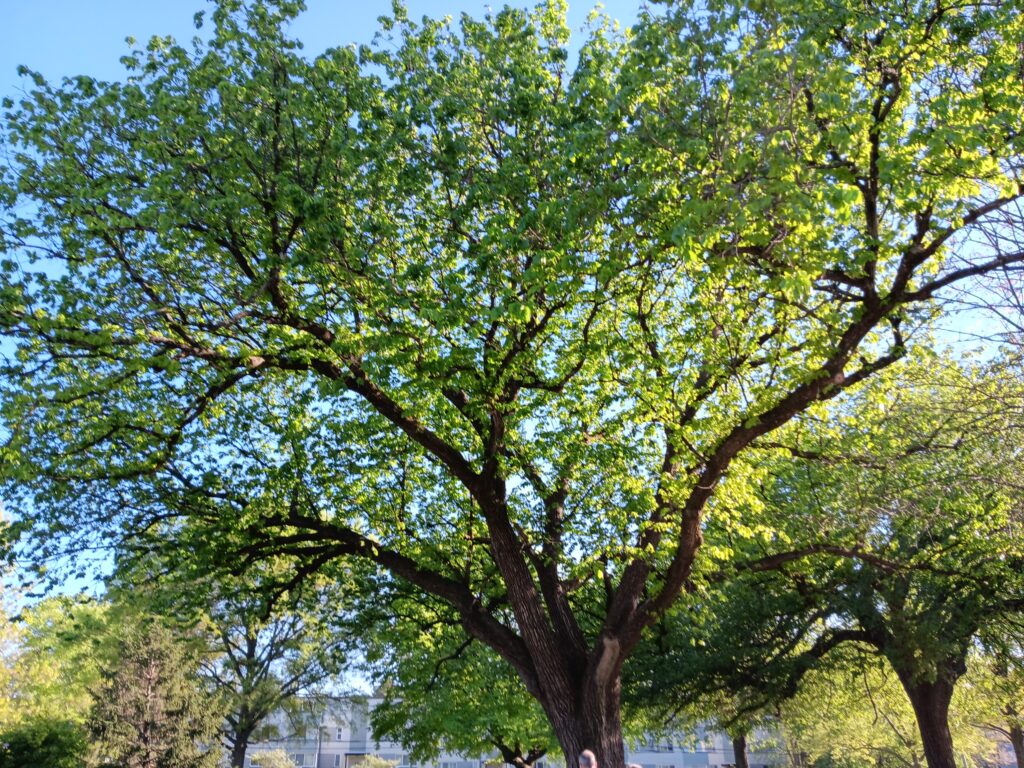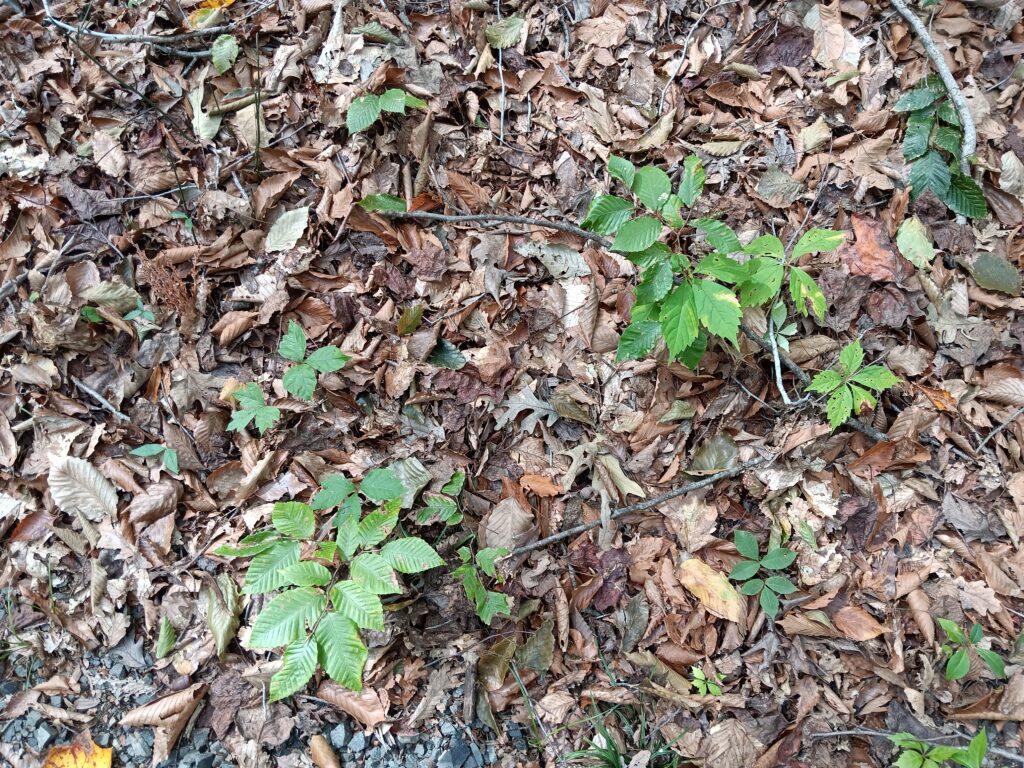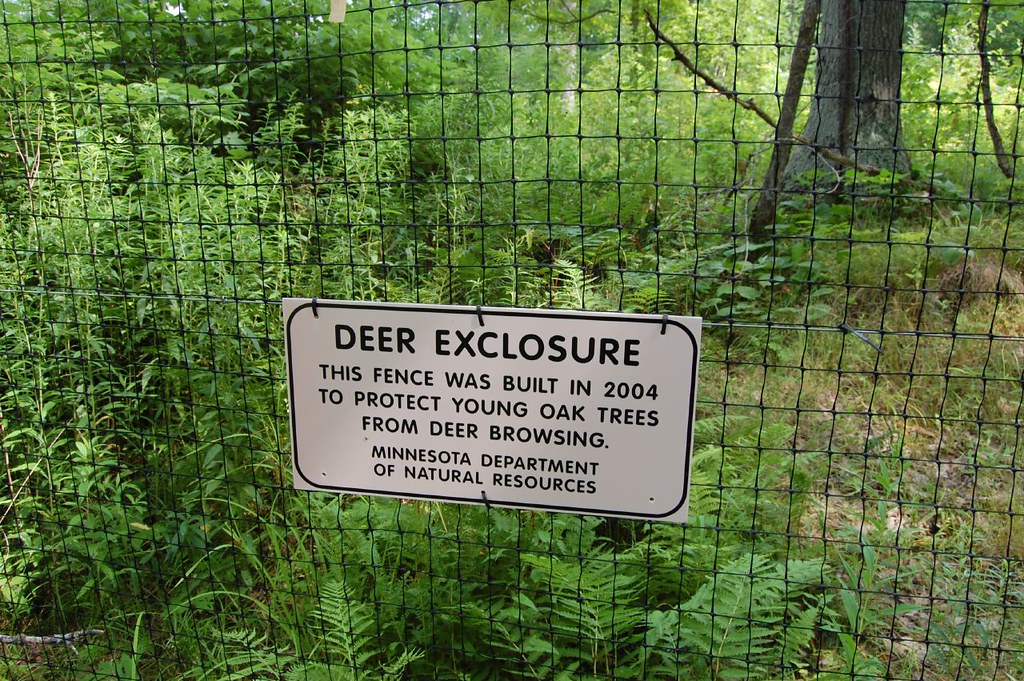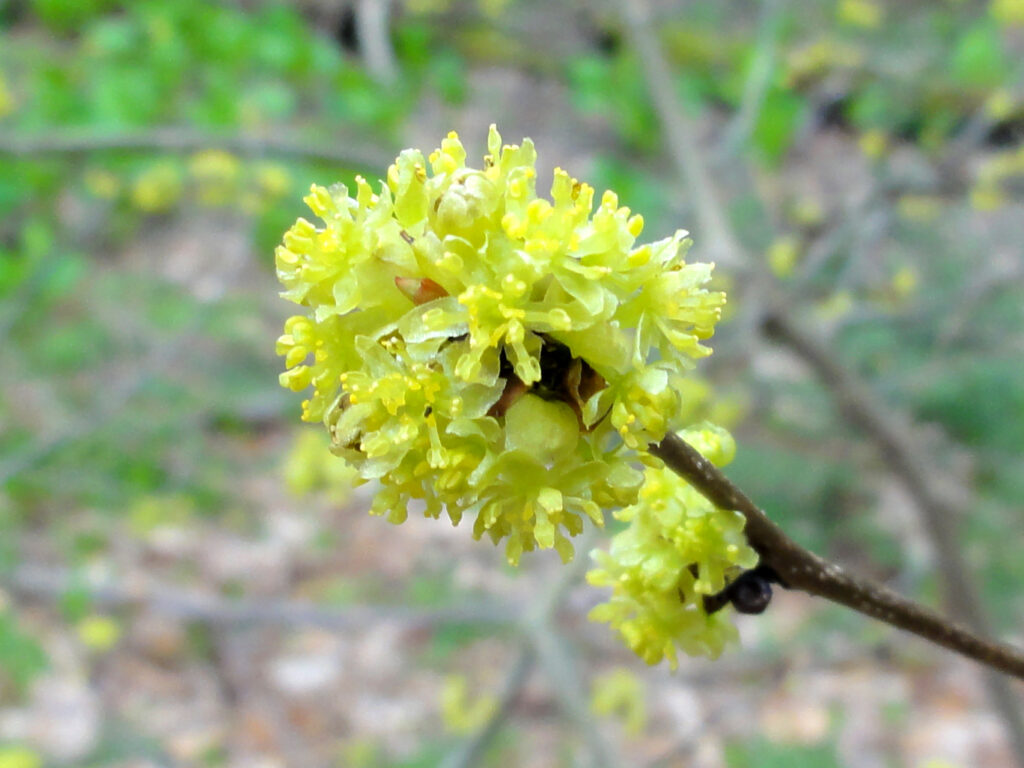I have recently recent blogged several times about threats to regeneration of eastern forests. Most of the underlying studies stress the role of deer browsing as a major driver of suppression of native plant species and proliferation of non-native ones. Most studies discussed at a recent Northern Hardwood research forum (USDA, FS 2023b Proceedings) found that deer browsing overwhelms other disturbances, such as fire and canopy gaps that typically promote seedling diversity. Miller et al. also stressed the importance of the deer-invasive plant complex in interrupting regeneration in National parks. Reed et al. found that, on the Allegheny Plateau of western Pennsylvania, high deer densities at the time stands formed reduced tree species diversity, density, and basal area – changes that were still detectable decades later.
On the other hand, Hovena et al. found that at their study sites in Ohio, interaction between non-native shrubs and soil wetness overshadowed even the impact of deer herbivory on the species richness and abundance of seedlings.
Unlike the others, Ducey et al. don’t mention deer as a factor in their analysis of regeneration in a forest in the northern half of New Hampshire. They focus on the minimal impact of silvicultural management. Its effect is secondary to overall forest development as the forest ages. Is it possible that overabundant deer are not a factor in the Bartlett Experimental forest.

Some of the studies acknowledge the impacts of non-native insects and pathogens. The most thorough discussion is in Payne and Peet. They note that specialist pathogens have caused the loss of important tree species, specifically elms and dogwoods plus the impending widespread mortality of ash. Such mortality is resulting in drastic and long-lasting shifts in community dynamics.
Ducey et al. anticipate pest-driven reversals of increases over the decades of eastern hemlock (Tsuga canadensis) and American beech (Fagus grandifolia). Also, they expect that white ash (Fraxinus americana), which has a minor presence, will disappear.
Miller et al. also stressed the importance of emerald ash borer-induced suppression of ash regeneration in some National parks . The authors also noted the threat to beech trees from beech leaf disease in other parks. Hovena et al. state that the interaction between non-native shrubs and soil wetness was more influential than ash mortality in shaping woody seedling communities.
Reed et al. considered the role of non-native earthworm biomass on plant species’ growth.
But too many of the studies, in my view, make no mention of the probably significant role of non-native insects and pathogens.
It is perhaps understandable that they don’t address emerging pests that either have not yet or have barely reached their study sites. For example, Hovena et al. and Yacucci et al. [see below] noted growth of one native shrub, Lindera benzoin, in the face of the challenges presented by deer and invading plants. Neither acknowledges the approach of laurel wilt disease, which has not yet become established in Ohio (it has been detected on the Kentucky-Indiana border). Similarly, neither mentions beech leaf disease, although some of the plots studied by Hovena et al. are just east of Cleveland – where BLD was first detected. The location of the Yacucci et al. study is less than 50 miles away. The North Carolina forests studied by Payne and Peet are apparently too far east to be affected by beech bark disease and beech leaf disease is not yet established nearby.
Less understandable is the failure to mention loss of elms – which were abundant in riparian areas until killed off by Dutch elm disease – which was first detected in Cleveland!); or to discuss the impact of dogwood anthracnose. Their focus on the deciduous forest might explain why they don’t mention hemlock woolly adelgid – which is just now invading the area discussed by Reed et al. I suppose the demise of American chestnut was so many decades ago that it is truly irrelevant to current forest dynamics.
A new study raises anew these questions about whether inattention to the role of non-native pests has skewed past studies’ results. Yacucci et al. compared regeneration in a military installation (Camp Garfield), to the results in the surrounding second-growth forest. This choice allowed them to overcome one drawback of other studies: using deer exclosures that are small and of short durations. The military facility covers 88 km2. Inside it, deer populations have been controlled for 67 years at a density of 6.6 – 7.5 deer/km2. Outside, deer have been overabundant for decades. Populations have grown to densities estimated (but not measured) to be at least 30 deer/km2 – more than four times as high.
These authors established 21 experimental gaps in the low-deer-density area and 20 gaps outside the installation where deer densities are high. Some of the gaps in both low- and high-deer-density environs were located on wetter, seasonally flooded soils, some on drier sites. None of the forest sites had experience fire in recent decades.
Their findings support the importance of deer browsing as driver of changes to forest regeneration.
They found that at low deer densities, gaps develop a vigorous and diverse native sapling layer, including oaks. Total stem density of red and pin oaks was 13 times higher in these gaps than in gaps in high-deer-density locations. Oak saplings were growing into the subcanopy – that is, above deer browse heights. Saplings of other species – i.e., tuliptree (Liriodendron tulipifera), red maple, and ash (Fraxinus spp.) were also flourishing. Also present were dogwood (Cornus florida) and two native shrubs — Lindera benzoin and Rubus allegheniensis. One non-native shrub, buckthorn (Rhamnus frangula), also thrived at low deer densities. Other non-native plant species were far fewer; their cover was 80% lower. Overall, abundance, richness, and diversity of native herbaceous and woody species were 37–65% higher at the low-deer-density study sites. On average tree species were more than twice as tall as in high-deer-density plots.
In high-deer-density plots, non-native species were six times more abundant while native species richness was 39% lower. Diversity was 27% lower. Most native tree species were short in stature and in low abundance. The one exception was black cherry (Prunus serotina), which deer avoid feeding on. The cherry was 95% more abundant in these high-deer-density plots.
There were several surprising results. In most cases, neither years since gap formation nor habitat type (wet vs. dry) had a significant impact on plant diversity, richness, or abundance. The exception was that non-native plant species were more abundant in older gaps where deer densities were high. Yacucci et al. warn that this phenomenon is a potential threat to biodiversity since high deer density is now the norm across eastern forests.
The authors also note that fire has probably never been a factor in these forests, which are primarily beech-maple forests. Certainly there have been no fires over the past 70 years, either inside or outside the military installation.
Yacucci et al. did not discuss past or possible future impacts of non-native insects or pathogens. They did not mention emerald ash borer or dogwood anthracnose – both of which had been present in Ohio for at least two decades when they completed their study. Although they said their study forest was a beech-maple forest, they did not discuss whether beech are present and – if so – the impact of beech bark disease or beech leaf disease. Both of these are spreading in Ohio. The latter was originally detected in 2012 near Cleveland, just 50 miles from the location of Camp Garfield (between Youngstown and Cleveland, Ohio). As noted above, they also did they mention that Lindera benzoin is susceptible to laurel wilt disease.

Proposed solutions to deer over-browsing
Given the combined threat from widespread deer overpopulation and invasions by non-native plants, Yacucci et al. propose enlisting those military posts that regularly cull deer into efforts to conserve and regenerate native plants. Otherwise, they say, the prognosis for regeneration is poor.
Bernd Blossey and colleagues propose a more sweeping solution: implementation of a national policy to reduce deer populations on all land ownerships. They point out that overabundant deer:
- disrupt the plant communities of affected forests – from spring ephemerals to tree regeneration;
- promote disease in wildlife and people; and
- lead to miserable deaths of deer on our highways, through winter starvation, and disease.
They call for federal leadership of coordinated deer-reduction programs. I discuss their proposal in detail in a separate blog.
SOURCES
Ducey, M.J, O.L. Fraser, M. Yamasaki, E.P. Belair, W.B. Leak. 2023. Eight decades of compositional change in a managed northern hardwood landscape. Forest Ecosystems 10 (2023) 100121
Hovena, B.M., K.S. Knight, V.E. Peters, and D.L Gorchov. 2022. Woody seedling community responses to deer herbivory, intro shrubs, and ash mortality depend on canopy competition and site wetness. Forest Ecology and Management. 523 (2022) 120488
Payne, C.J. and R.K. Peet. 2023. Revisiting the model system for forest succession: Eighty years of resampling Piedmont forests reveals need for an improved suite of indicators of successional change. Ecological Indicators 154 (2023) 110679
Miller, K.M., S.J. Perles, J.P. Schmit, E.R. Matthews, and M.R. Marshall. 2023. Overabundant deer and invasive plants drive widespread regeneration debt in eastern United States national parks. Ecological Applications. 2023;33:e2837. https://onlinelibrary.wiley.com/r/eap Open Access
Reed, S.P., D.R. Bronson, J.A. Forrester, L.M. Prudent, A.M. Yang, A.M. Yantes, P.B. Reich, and L.E. Frelich. 2023. Linked disturbance in the temperate forest: Earthworms, deer, and canopy gaps. Ecology. 2023;104:e4040. https://onlinelibrary.wiley.com/r/ecy
United States Department of Agriculture, Forest Service. 2023a. Proceedings of the First Biennial Northern Hardwood Conference 2021: Bridging Science and Management for the Future. Northern Research Station General Technical Report NRS-P-211 May 2023
Yacucci, A.C., W.P. Carson, J.C. Martineau, C.D. Burns, B.P. Riley, A.A. Royo, T.P. Diggins, I.J. Renne. 2023. Native tree species prosper while exotics falter during gap-phase regeneration, but only where deer densities are near historical levels New Forests https://doi.org/10.1007/s11056-023-10022-w
Posted by Faith Campbell
We welcome comments that supplement or correct factual information, suggest new approaches, or promote thoughtful consideration. We post comments that disagree with us — but not those we judge to be not civil or inflammatory.
For a detailed discussion of the policies and practices that have allowed these pests to enter and spread – and that do not promote effective restoration strategies – review the Fading Forests report at http://treeimprovement.utk.edu/FadingForests.htm
or

